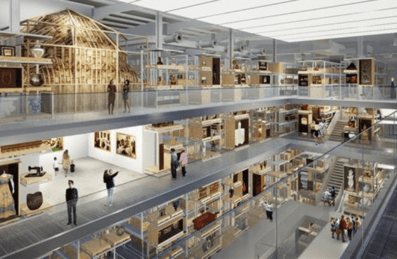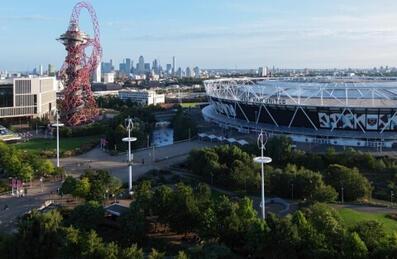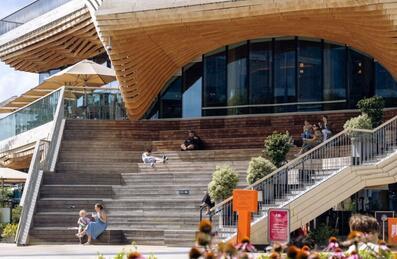
Popular Searches:
Keep up to date
Sign up today for exclusive offers and incredible experiences you won’t want to miss at Queen Elizabeth Olympic Park.
Sign up nowSmart detectors to monitor urban bat life
Smart detectors to monitor urban bat life
Press Release 29/06/2017
The activity of urban bats in Queen Elizabeth Olympic Park in London is being monitored in real-time using new, automated smart detectors that have been developed and installed by UCL and Intel scientists in collaboration with Arup, the Bat Conservation Trust, and the London Wildlife Trust.
Urban Bat Life
Bats are a good indicator species, so are often used to measure how healthy our environment is. By detecting bat ultrasonic calls, the monitors will track species present and their activity levels and display the information to the public. This will provide an insight into the wildlife health of the Park over the next year, and help to inform its management.
David Goldstone, Chief Executive, London Legacy Development Corporation, said: “We’re keen to protect and improve the quality of the environment that’s been created here on the Park. And it’s great that the world-leading universities who are coming to Stratford are also developing this fantastic technology to help look after the environment.”
“We are trialling a network of smart bat monitors that listen to the environment, and figure out if bats are present, all in real time. It’s a ‘Shazam’ for bats! It’s a huge step forward for detection technology - an Internet of Wild Things, and we hope it will help understand how wildlife is being impacted by rapid environmental change,” said Professor Kate Jones, project lead and Chair of Ecology and Biodiversity at UCL.
The detectors are the result of a project called Nature Smart Cities, which brought environmental, statistical, and computing researchers together with technologists to develop this pilot of the world’s first end-to-end open source system for monitoring bats.
“Measuring bat activity in the Queen Elizabeth Olympic Park is a very interesting challenge that involves large amounts of acoustic sensor data. Each device applies machine learning techniques to process the data itself on its own chip. We call it ‘edge processing’ since it happens on sensor devices at the edge of the network, instead of sending gigabytes of data across a network to a cloud,” said Dr Sarah Gallacher from Intel Labs Europe.
The installation of detectors at 15 sites across the Park began in late May, once the bats came out of hibernation. The detectors are connected to wifi and a power supply to enable them to record data and give reliable results quickly. They will be covering a large area and will be constantly recording over a long period of time.
“Smart detectors are revolutionary, as before now, analysing recordings was costly and, labour intensive. For my team, our challenge was to develop a deep neural network that can run on a tiny, low-power computer-on-a-chip outdoor sensor,” explained Dr Gabriel Brostow, who led the team of computer scientists at UCL.
Each bat monitor uses an ultrasonic microphone to capture audio in its surroundings up to frequencies of 96kHz. Bat calls are normally at frequencies above 20kHz, which is the limit of human hearing, with some species calls over 125kHz, but these species are very unlikely to be found in the Park.
The captured audio is then turned into an image called a spectrogram. Statistical machine learning algorithms, developed by scientists from UCL and the University of Warwick as part of an Engineering and Physical Sciences Research Council-funded project, scan the spectrogram image, identifying possible bat calls. The algorithms ignore any sounds below 20kHz – in the human range – and captured audio is then deleted after bat results are extracted.
Live data from the bat sensors can be viewed on the project website. The bat sensor trial will run on the Park until the end of the year, and findings on what has been learned about bat biodiversity at the park will be available towards the end of 2017.
Notes to Editors
For more information or to speak to the researchers involved, please contact Dr Rebecca Caygill, UCL press office. T: +44 (0)20 3108 3846 / +44 (0)7733 307 596, E: r.caygill@ucl.ac.uk
Website: www.naturesmartcities.com
Connected projects:
About UCL (University College London)
UCL was founded in 1826. We were the first English university established after Oxford and Cambridge, the first to open up university education to those previously excluded from it, and the first to provide systematic teaching of law, architecture and medicine. We are among the world's top universities, as reflected by performance in a range of international rankings and tables. UCL currently has over 39,000 students from 150 countries and over 12,500 staff. Our annual income is more than £1 billion.
www.ucl.ac.uk | Follow us on Twitter @uclnews | Watch our YouTube channel YouTube.com/UCLTV
About Queen Elizabeth Olympic Park
Promoting biodiversity and conservation in urban spaces has been a key part of the transformation of Queen Elizabeth Olympic Park and its surrounding neighbourhoods into a smart, sustainable district. Since the Games the Park has become home to wide array of wildlife, with green and blue infrastructure providing links for nature through the park and into adjacent areas. Bat conservation has been a focus for the Park, with 150 bat boxes providing habitat for the UK’s smallest bat – common pipistrelle – and also the UK’s largest bat – the noctule.
The London Legacy Development Corporation has been working closely with UK and international partners to develop Queen Elizabeth Olympic Park as The Smart Park, using leading edge technology to promote its sustainability objectives. This includes provision of free Wi-Fi for visitors across all 560 acres of the Park, making it the largest public Wi-Fi network of its kind in the world, implementing energy efficiency innovations in Park venues, creating new approaches to sensing and communicating data, and providing urban test bed space for the development of new technology – such as connected and autonomous vehicles.
About Arup
Arup is the creative force at the heart of many of the world’s most prominent projects in the built environment and across industry. From 92 offices in 40 countries our 13,000 planners, designers, engineers and consultants deliver innovative projects across the world with creativity and passion. www.arup.com
Bat Conservation Trust (BCT) are the leading national charity solely devoted to the conservation of bats and the landscapes on which they rely. We work closely with many organisations including over 100 bat groups across the UK. We are working to secure the future of bats in our ever changing world by tackling the threats to bats, from persecution to loss or roosts and changing land use. As the authoritative voice for bat conservation we work locally, nationally, across Europe and internationally. BCT have a vision of a world rich in wildlife where bats and people thrive together. www.bats.org.uk
About the London Wildlife Trust
London Wildlife Trust is the only charity dedicated solely to protecting the capital's wildlife and wild spaces, engaging London's diverse communities through access to our nature reserves, campaigning, volunteering and education. We engage with research partners to find innovative means to monitor and study the city’s biodiversity and help people make informed decisions to better conserve and promote London’s precious ecological assets. Visit www.wildlondon.org.uk
The Engineering and Physical Sciences Research Council (EPSRC)
As the main funding agency for engineering and physical sciences research, our vision is for the UK to be the best place in the world to Research, Discover and Innovate.
By investing £800 million a year in research and postgraduate training, we are building the knowledge and skills base needed to address the scientific and technological challenges facing the nation. Our portfolio covers a vast range of fields from healthcare technologies to structural engineering, manufacturing to mathematics, advanced materials to chemistry. The research we fund has impact across all sectors. It provides a platform for future economic development in the UK and improvements for everyone’s health, lifestyle and culture.
We work collectively with our partners and other Research Councils on issues of common concern via Research Councils UK. www.epsrc.ac.uk






